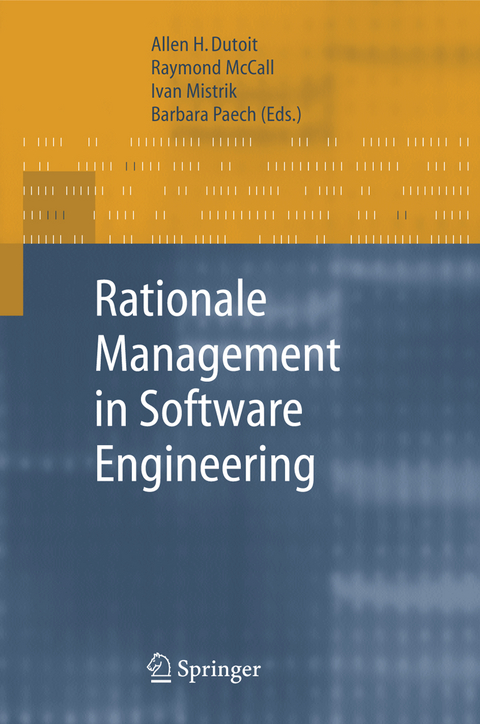
Rationale Management in Software Engineering
Springer Berlin (Verlag)
978-3-642-06816-4 (ISBN)
Alllen Dutoit ist wissenschaftlicher Assistent am Lehrstuhl für Angewandte Softwaretechnik der Technischen Universität München und arbeitet an einer Habilitation im Bereich des Begründungsmanagements.
Fundamentals - Rationale Representation, Capture, and Use.- Rationale Management in Software Engineering: Concepts and Techniques.- Three Studies of Design Rationale as Explanation.- Effective Design Rationale: Understanding the Barriers.- Rationale as a By-Product.- Hypermedia Support for Argumentation-Based Rationale.- Rationale Management for Requirements Engineering.- A Hybrid Approach to Upstream Requirements: IBIS and Cognitive Mapping.- From DREAM to Reality: Specificities of Interactive Systems Development With Respect To Rationale Management.- The WinWin Approach: Using a Requirements Negotiation Tool for Rationale Capture and Use.- Design Rationale in Exemplary Business Process Modeling.- Promoting and Supporting Requirements Engineering Creativity.- Design Rationale and Software Architecting.- A Framework for Supporting Architecture Knowledge and Rationale Management.- Capturing and Using Rationale for a Software Architecture.- Rationale-Based Support for Software Maintenance.- The Role of Rationale in the Design of Product Line Architectures - A Case Study from Industry.- The Role and Impact of Assumptions in Software Engineering and its Products.- Design Decisions: The Bridge between Rationale and Architecture.- Rationale for Organizing Bodies of Knowledge.- Reusable Rationale Blocks: Improving Quality and Efficiency of Design Choices.- Defining Agile Patterns.- Capturing and Reusing Rationale Associated with Requirements Engineering Process Improvement: A Case Study.- Using Patterns for Sharing Requirements Engineering Process Rationales.
Ten years ago, with Tom Moran, I edited a book entitled "Design Rationale." I think that book has held up quite well, though a decade onward it does seem a bit prefatory. It is past time for another detailed summary of research on design rationale. Allen Dutoit, Ray McCall, Ivan Mistrik and Barbara Paech have done an excellent job of this in "Rationale management in software engineering." The chapters in this volume show how design rationale can be incorporated into the heart of the software development process - into requirements engineering, software architecture, and code design. (John Carroll, School of Information Sciences and Technology, Penn State University, USA)
| Erscheint lt. Verlag | 21.9.2014 |
|---|---|
| Zusatzinfo | XXII, 434 p. |
| Verlagsort | Berlin |
| Sprache | englisch |
| Maße | 155 x 235 mm |
| Gewicht | 694 g |
| Themenwelt | Informatik ► Software Entwicklung ► User Interfaces (HCI) |
| Mathematik / Informatik ► Informatik ► Theorie / Studium | |
| Informatik ► Weitere Themen ► Hardware | |
| Mathematik / Informatik ► Mathematik ► Finanz- / Wirtschaftsmathematik | |
| Schlagworte | Architecture • Design • Development • IBIS • knowledge management • Management • Modeling • QoC • Rationale Management • Requirements Engineering • Software • software architecture • software development • Software engineering • software maintenance • structured analysis • Technolo |
| ISBN-10 | 3-642-06816-2 / 3642068162 |
| ISBN-13 | 978-3-642-06816-4 / 9783642068164 |
| Zustand | Neuware |
| Haben Sie eine Frage zum Produkt? |
aus dem Bereich


